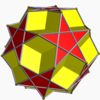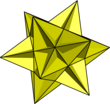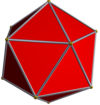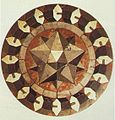小星形十二面体
 (按这里观看旋转模型) | ||||||||||||||||
| 类别 | 克卜勒-庞索立体 星形十二面体 | |||||||||||||||
|---|---|---|---|---|---|---|---|---|---|---|---|---|---|---|---|---|
| 对偶多面体 | 大十二面体 | |||||||||||||||
| 识别 | ||||||||||||||||
| 名称 | 小星形十二面体 | |||||||||||||||
| 参考索引 | U34, C43, W20 | |||||||||||||||
| 鲍尔斯缩写 | sissid | |||||||||||||||
| 数学表示法 | ||||||||||||||||
| 考克斯特符号 | ||||||||||||||||
| 施莱夫利符号 | {5/2,5} | |||||||||||||||
| 威佐夫符号 | 5 | 2 5⁄2 | |||||||||||||||
| 康威表示法 | lsD | |||||||||||||||
| 性质 | ||||||||||||||||
| 面 | 12 | |||||||||||||||
| 边 | 30 | |||||||||||||||
| 顶点 | 12 | |||||||||||||||
| 欧拉特征数 | F=12, E=30, V=12 (χ=-6) | |||||||||||||||
| 亏格 | 4 | |||||||||||||||
| 二面角 | acos ≈ 116.565051177 度 | |||||||||||||||
| 组成与布局 | ||||||||||||||||
| 面的种类 | 12个正五角星 | |||||||||||||||
| 面的布局 | V(55)/2 | |||||||||||||||
| 顶点图 | (5⁄2)5 | |||||||||||||||
| 顶点的种类 | 12个5阶顶点 | |||||||||||||||
| 对称性 | ||||||||||||||||
| 对称群 | Ih, H3, [5,3], (*532) | |||||||||||||||
| 旋转对称群 | I, [5,3]+, (532) | |||||||||||||||
| 特性 | ||||||||||||||||
| 正、非凸 | ||||||||||||||||
| 图像 | ||||||||||||||||
| ||||||||||||||||
| 相关多面体 | ||||||||||||||||
| 截角 | 截角小星形十二面体 | |||||||||||||||
| 截半 | 截半大十二面体 | |||||||||||||||
| 三角化(基于简单多面体) | 完全星形二十面体 | |||||||||||||||
小星形十二面体是一种星形正多面体,由12个五角星面组成,为三种星形十二面体之一。[1][2]小星形十二面体的凸包为正二十面体,而正二十面体的对偶多面体为正十二面体,因此小星形十二面体的对偶多面体也是一种星形十二面体——大十二面体;[3]:40此外,其顶点的布局与正二十面体相同,但边的连结方式不同,因此可以视为正二十面体经过刻面后的多面体。[4]小星形十二面体的拓朴结构与大十二面体相同,皆对应到亏格为4的五阶五边形正则地区图(施莱夫利符号:{5,5}),[5]因此小星形十二面体和大十二面体皆可以视为抽象多面体{5,5}6[注 1]在三维空间中的一种具象化形式。[6]这个多面体最早由约翰内斯·开普勒于1619年观察并描述,[7]并于1809年由路易·庞索重新发现;[8]1859年阿瑟·凯莱对这种形状进行进一步的研究并将之命名为小星形十二面体(Small stellated dodecahedron)。[9]
有些艺术家会利用小星形十二面体的星状外形作为表达天体意象的方式,例如在艾雪的作品《重力》中就使用了小星形十二面体作为创作中的主要元素。[10][11]
历史
[编辑]小星形十二面体的形状最早出现于保罗·乌切洛在1430年创作于威尼斯圣马尔谷圣殿宗主教座堂地板上的镶嵌艺术中,然而当时尚未对这种形状的性质进行探讨,仅作为艺术作品的要素之一。[12]1619年,约翰内斯·开普勒在其著作《世界的和谐》中针对部分星形多面体进行了一些研究,[13]当中包括了大星形十二面体与小星形十二面体。[7]1809年路易斯·庞索重新发现了开普勒先前发现的星形多面体并另外发现了两个星形多面体:大二十面体与大十二面体,因此这四个立体现今合称为克卜勒-庞索立体。[8]1859年,阿瑟·凯莱对这种形状进行了较详细的描述,并将其命名为小星形十二面体(Small stellated dodecahedron),[9]同时这也是这种立体首次在正式文献中获命名。[7]然而,由于这个立体由12个面、30条边和12个顶点组成,而这些数值代入当时认为能普遍适用于各种多面体的欧拉示性数得到了不是2的结果,与当时普遍的认知相左,因此这种几何结构一度被认为不应存在。[14]这个问题后来在克莱茵的著作中得到了解答,[15]这个立体代表著一个亏格为4的黎曼曲面。[16]
性质
[编辑]小星形十二面体由组成12个面、30条边和12个顶点组成,[17]其中,12个面皆为正五角星;在组成小星形十二面体的12个顶点中,每个顶点都是5个五角星的公共顶点,在顶点图中,可使用五边形来表示;[18][4]每条边皆等长,且皆为2个正五角星的公共边。由此可知,这个立体具备了所有面全等、所有边等长、所有角等角的性质,是一种正多面体,然而这种立体是一个非凸多面体,因此不在古典的5种多面体中,是4个非凸正多面体之一,[8]由12个五角星面(6对平行五角星)所组成。小星形十二面体在施莱夫利符号中利用{5/2,5}来表示,这个符号代表了每个顶点都是5个五角星的公共顶点,在考克斯特符号中利用![]()
![]()
![]()
![]()
![]()
![]()
![]() 来表示。[19]
来表示。[19]
构造
[编辑]小星形十二面体是一种星形十二面体,其可透过延伸正十二面体的面来构成,[4]这个操作就有如将正五边形的边延伸至相交,构成正五角星;同理,小星形十二面体则为将正十二面体以正五边形延伸成正五角星的方式,将面延伸至相交。这个操作将在正十二面体的每个面上加入一个五角锥,锥高为。[19]
二面角
[编辑]小星形十二面体是一种星形正多面体,因此具有所有角相等的性质。其二面角只有一个值,其值为负五平方根倒数之反馀弦:[17]
面的组成
[编辑]小星形十二面体由12个五角星面组成,这些五角星皆全等,并且其构成方式为由正五边形的顶点,以间隔为2的方式相接,在施莱夫利符号中可以用{5/2}来表示,[20]而小星形十二面体每个顶点都是5个五角星面的公共顶点,在施莱夫利符号中表示为{5/2,5}。在拓朴学上,这种结构与{5,5}无异,因此小星形十二面体也可以视为将五阶五边形镶嵌这种双曲镶嵌局部区域闭合后的结果。[20]
 以黄色表示小星形十二面体的五角星面 |
 小星形十二面体 |
 将一个面以蓝色表示,其他面不著色 |
此外,亦可以将小星形十二面体化为简单多面体,即排除面与面自相交的情况。通常用于制作小星形十二面体的模型,因为自相交的面不容易用实体模型实现,此时会将小星形十二面体的12个五角星面分割成60个等腰三角形面。[21]
拓朴
[编辑]若将小星形十二面体的五角星依照复杂多边形的方式[注 2]分解成5个等腰三角形,则其拓朴结构将与五角化十二面体等价,只是前者的锥高更高,而使其成为非凸多面体;[19]若将五角化十二面体的原像——正十二面体视为一个截对角偏方面体,则对应的小星形十二面体则为该5个侧面所加入的5个角锥中,5个侧面共面成五角星。另一方面,若使小星形十二面体的五角星维持原样,则其拓朴结构与大十二面体相同,并对应相同的正则地区图,[24]对应的骨架图为二十面体图。[25][24]
小星形十二面体由12个五角星、30条边和12个顶点组成,可以透过欧拉公式计算其亏格:
由此可知,小星形十二面体代表了一个亏格为4的曲面。这个特性最初被路易斯·波因索观察到时,十分令人困惑,[15]而费利克斯·克莱因在1877年表明,小星状十二面体可以被视为亏格为4之黎曼曲面被黎曼球面分支覆盖的结果,其分支点位于每个五角星的中央。[16]而这个黎曼曲面称为布林曲线,其对称性是所有亏格为4之黎曼曲面中最多的,对应自同构群为对称群。[26]
使用
[编辑]不少艺术家有使用小星形十二面体进行创作,例如保罗·乌切洛在1430年创作于威尼斯圣马尔谷圣殿宗主教座堂地板上的镶嵌艺术中就能发现小星形十二面体的踪影;[12]相同的形状也出现在两件莫里茨·科内利斯·埃舍尔的两件石版印刷作品中,分别是1950年创作的《Contrast》与1952年创作的《重力》。[10]
相关多面体与镶嵌
[编辑]部分多面体与镶嵌与小星形十二面体有一些几何关联。例如部分多面体可透过小星形十二面体经过康威变换而得到,例如截角大十二面体、截半大十二面体[27]、以及其对偶多面体大十二面体[19]。
| 关联 | 原像 | 对偶多面体 | 皮特里对偶 |
|---|---|---|---|
| 名称 | 小星形十二面体 | 大十二面体 | 皮特里小星形十二面体 |
| 施莱夫利符号 | {5/2,5} | {5,5/2} | {5/2,5}π |
| 图像 | 
|

|

|
截角小星形十二面体
[编辑]
截去所有顶点的小星形十二面体[注 3][31]可构成一个外观与正十二面体无异的退化均匀多面体。[32][33]这种多面体在考克斯特记号中可以用![]()
![]()
![]()
![]()
![]()
![]()
![]() 表示。[34]虽然其外观与正十二面体无异,然而这种立体并非十二面体,而是一种退化的二十四面体,其由24个面、90条边和60个顶点组成,其中24个面为12个正五边形和12个绕两圈的正五边形组成,整体可以视为是每个顶点都是2个十边形和1个五边形之公共顶点的抽象等角二十四面体的具像化。[35]
表示。[34]虽然其外观与正十二面体无异,然而这种立体并非十二面体,而是一种退化的二十四面体,其由24个面、90条边和60个顶点组成,其中24个面为12个正五边形和12个绕两圈的正五边形组成,整体可以视为是每个顶点都是2个十边形和1个五边形之公共顶点的抽象等角二十四面体的具像化。[35]
不同的截角深度也会产生不同的几何体:
| 名称 | 小星形十二面体 | 截角小星形十二面体 | 截半大十二面体 | 截角大十二面体 | 大十二面体 |
|---|---|---|---|---|---|
| 考克斯特 迪肯符号 |
|||||
| 图像 | 
|

|

|

|

|
简单多面体
[编辑]
小星形十二面体可以化为简单多面体,此时会将小星形十二面体的12个五角星面分割成60个等腰三角形面,[21]此时其拓朴结构将与五角化十二面体等价,[19]由60个面、90条边和32个顶点组成。[36]这种立体可以三角化成其他立体:

|

|

|

|

|

|
| 大二十面体 | 向内加入角锥 | (原始形状) | 向外加入角锥 | 完全星形二十面体 | |
贝齐奥立体
[编辑]让-伊夫·贝齐奥曾在其论文中探讨星形十二面体,[37]但不慎将以五边形组成的正十二面体之星形化体与菱形组成的菱形十二面体之星形化体搞混了。后来莫雷帝将其描述为在正十二面体的面上加入五角锥组成的立体,[38]即小星形十二面体。 后来,汉士·史梅斯特(Hans Smessaert)等人才以星形四角化菱形十二面体的结构完成贝齐奥最初探讨的议题。[39]
 莫雷帝描述的贝齐奥立体 (实为小星形十二面体) |
 汉士·史梅斯特描述的贝齐奥立体 |
星形镶嵌图
[编辑]其也可以视为一系列施莱夫利符号中可利用{n/2,n}表示的星形镶嵌之一,例如七阶七角星镶嵌:[40][41]
| 对称群 *n32 [n,3] |
球面镶嵌 | 平面镶嵌 | 双曲镶嵌 | 仿紧凑 | 非紧凑 | |||||
|---|---|---|---|---|---|---|---|---|---|---|
| *532 [5,3] |
*632 [6,3] |
*732 [7,3] |
*832 [8,3] |
*932 [9,3] |
*10 32 [10,3]... |
*∞32 [∞,3] |
[iπ/λ,3] | |||
| 考克斯特纪号 | ||||||||||
| 星形 顶点 布局 |
 (5⁄2)5 |
 (6⁄2)6 |
 (7⁄2)7 |
 (8⁄2)8 |
 (9⁄2)9 |
 (10⁄2)10 |
 (∞⁄2)∞ |
(∞⁄2)∞ | ||
| 面 | 
|

|

|

|

|

|
||||
| 星形对偶 | ||||||||||
| 考克斯特纪号 | ||||||||||
| 星形 顶点 布局 |
 (55)∕2 |
 (66)∕2 |
 (77)∕2 |
 (88)∕2 |
 (9⁄2)9 |
 (10⁄2)10 |
  (偶数)(奇数) (∞∞)∕2 |
(∞∞)∕2 | ||
对偶复合体
[编辑]小星形十二面体与其对偶多面体的复合体为复合小星形十二面体大十二面体。其共有24个面、60条边和24个顶点,其尤拉示性数为-12,亏格为7,[42]而在这个立体图形中,仅有小星形十二面体可见,大十二面体完全隐没于小星形十二面体而不可见。[43]
参见
[编辑]注释
[编辑]- ^ {5,5}6为施莱夫利符号,其代表了每个顶点都是5个五边形的公共顶点,并具有六边形的皮特里多边形。
- ^ 在复杂多边形中,自相交偶数次的部份算做多边形的外部,[22]以此例而言,五角星中央交出的五边形不算做五角星的内部,换句话说,即是此复杂多边形的孔洞。[23]
- ^ 产生半正多面体所用的截角,即确保截角完后的面皆要等边的截角。[29][30]
参考文献
[编辑]- ^ Weisstein, Eric W. (编). Dodecahedron Stellations. at MathWorld--A Wolfram Web Resource. Wolfram Research, Inc. (英语).
- ^ Wenninger, M. J. Polyhedron Models. New York: Cambridge University Press. 1989: 35, 38-40.
- ^ Wenninger, Magnus, Dual Models, Cambridge University Press, 2003 [1983], ISBN 978-0-521-54325-5, MR 0730208, doi:10.1017/CBO9780511569371
- ^ 4.0 4.1 4.2 Nan Ma. Small stellated dodecahedron {5/2, 5}.
- ^ Stellation of Regular Maps. Regular Map database, weddslist.com. [2021-07-30]. (原始内容存档于2021-08-23).
- ^ Richard Klitzing. sissid (small stellated dodecahedron). bendwavy.org. [2021-08-21]. (原始内容存档于2021-07-26).
- ^ 7.0 7.1 7.2 Weisstein, Eric W. (编). Kepler-Poinsot Solid. at MathWorld--A Wolfram Web Resource. Wolfram Research, Inc. (英语).
- ^ 8.0 8.1 8.2 Louis Poinsot, Memoire sur les polygones et polyèdres. J. de l'École Polytechnique 9, pp. 16–48, 1810.
- ^ 9.0 9.1 Cayley, Arthur. XIX. On Poinsot's four new regular solids. The London, Edinburgh, and Dublin Philosophical Magazine and Journal of Science (Taylor & Francis). 1859, 17 (112): 123–128.
- ^ 10.0 10.1 Barnes, John. Gems of Geometry 2nd. Springer. 2012: 46.
- ^ Locher, J. L. (2000). The Magic of M. C. Escher. Harry N. Abrams, Inc. ISBN 0-8109-6720-0
- ^ 12.0 12.1 Coxeter, H. S. M. Regular and semiregular polyhedra. Senechal, Marjorie (编). Shaping Space: Exploring Polyhedra in Nature, Art, and the Geometrical Imagination 2nd. Springer. 2013: 41–52. doi:10.1007/978-0-387-92714-5_3. See in particular p. 42.
- ^ Johannes Kepler. Harmonices Mundi. Linz. 1619 (拉丁语).
- ^ Schläfli. On The Multiple Integral whose Limits Are and . Quart. J. Pure Appl. Math. 1860, 3: 54–68, 97–108,.
- ^ 15.0 15.1 Zvonkine, Alexandre. Functional composition is a generalized symmetry. Symmetry: Culture and Science. 2011, 22 (3-4): 391–426.
- ^ 16.0 16.1 Klein, Felix, Lectures on the icosahedron and the solution of equations of the fifth degree, Dover Phoenix Editions, New York: Dover Publications, 2003 [1884], ISBN 978-0-486-49528-6, MR 0080930
- ^ 17.0 17.1 Kepler-Poinsot Solids: Small Stellated Dodecahedron. dmccooey.com. [2021-08-20]. (原始内容存档于2021-08-20).
- ^ 7. Sissid, Polyhedron Category 1: Regulars. polytope.net. [2021-08-21]. (原始内容存档于2021-08-21).
- ^ 19.0 19.1 19.2 19.3 19.4 Weisstein, Eric W. (编). Small Stellated Dodecahedron. at MathWorld--A Wolfram Web Resource. Wolfram Research, Inc. (英语).
- ^ 20.0 20.1 J. Conrad, C. Chamberland, N. P. Breuckmann, B. M. Terhal. The small stellated dodecahedron code and friends. Philosophical Transactions of the Royal Society A: Mathematical, Physical and Engineering Sciences. 2018-07-13, 376 (2123): 20170323 [2021-08-20]. ISSN 1364-503X. PMC 5990658
 . PMID 29807900. doi:10.1098/rsta.2017.0323. (原始内容存档于2021-08-20) (英语).
. PMID 29807900. doi:10.1098/rsta.2017.0323. (原始内容存档于2021-08-20) (英语).
- ^ 21.0 21.1 Small Stellated Dodecahedron. coolmath. [2021-08-20]. (原始内容存档于2021-08-20).
- ^ Paul Bourke. Polygons and meshes:Surface (polygonal) Simplification. 1997 [2016-05].
- ^ Rae Earnshaw, Brian Wyvill (Ed); New Advances in Computer Graphics: Proceedings of CG International ’89, Springer, 2012, page 654.
- ^ 24.0 24.1 S4:{5,5}. Regular Map database - map details, weddslist.com. [2021-07-30].
- ^ Wolfram, Stephen. "Small stellated dodecahedron". from Wolfram Alpha: Computational Knowledge Engine, Wolfram Research (英语).
- ^ Weber, Matthias. Kepler's small stellated dodecahedron as a Riemann surface. Pacific J. Math. 2005, 220: 167–182. pdf (页面存档备份,存于互联网档案馆)
- ^ Holden, A. Shapes, Space, and Symmetry. New York: Dover,. 1991: 103.
- ^ Coxeter, H.S.M.; Regular Polytopes (third edition). Dover Publications Inc. ISBN 0-486-61480-8
- ^ Coxeter, H.S.M. Chapter 8: Truncation, Regular Polytopes,[28] pp. 145–154
- ^ Norman Johnson, Uniform Polytopes, Manuscript (1991)
- ^ Olshevsky, George, Truncation at Glossary for Hyperspace.
- ^ mathconsult. Background Information of Uniform polyhedra. [2021-08-20]. (原始内容存档于2020-02-24).
- ^ Maeder, Roman E. Uniform polyhedra. The Mathematica Journal (Citeseer). 1993, 3 (4): 48–57 [2021-08-20]. (原始内容存档于2021-08-23).
- ^ Coxeter, The Evolution of Coxeter-Dynkin diagrams, [Nieuw Archief voor Wiskunde 9 (1991) 233-248]
- ^ Grünbaum, Branko. Graphs of polyhedra; polyhedra as graphs. Discrete Mathematics (Elsevier). 2007, 307 (3-5): 445–463. doi:10.1016/j.disc.2005.09.037.
- ^ Ugo Adriano Graziotti. the realm of geometric beauty. University of San Francisco. [2021-08-20]. (原始内容存档于2021-08-23).
- ^ Béziau, Jean-Yves. New light on the square of oppositions and its nameless corner. Logical Investigations. 2003, 10 (2003): 218–232.
- ^ Moretti, Alessio. The critics of paraconsistency and of many-valuedness and the geometry of oppositions. Logic and Logical Philosophy. 2010, 19 (1-2): 63–94.
- ^ Smessaert, Hans and Demey, Lorenz, Béziau’s contributions to the logical geometry of modalities and quantifiers, The road to universal logic (Springer), 2015: 475–493
- ^ John H. Conway, Heidi Burgiel, Chaim Goodman-Strass, The Symmetries of Things 2008, ISBN 978-1-56881-220-5 (Chapter 19, The Hyperbolic Archimedean Tessellations)
- ^ Chapter 10: Regular honeycombs in hyperbolic space. The Beauty of Geometry: Twelve Essays. Dover Publications. 1999. ISBN 0-486-40919-8. LCCN 99035678.
- ^ compound of great dodecahedron and small stellated dodecahedron. bulatov.org. [2021-08-21]. (原始内容存档于2021-03-05).
- ^ Weisstein, Eric W. (编). Great Dodecahedron-Small Stellated Dodecahedron Compound. at MathWorld--A Wolfram Web Resource. Wolfram Research, Inc. (英语).




















